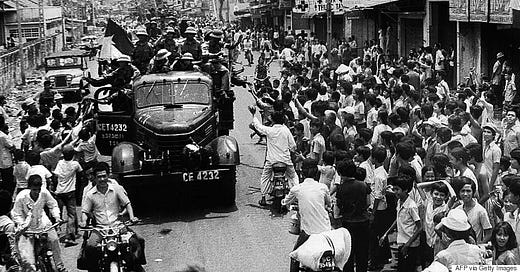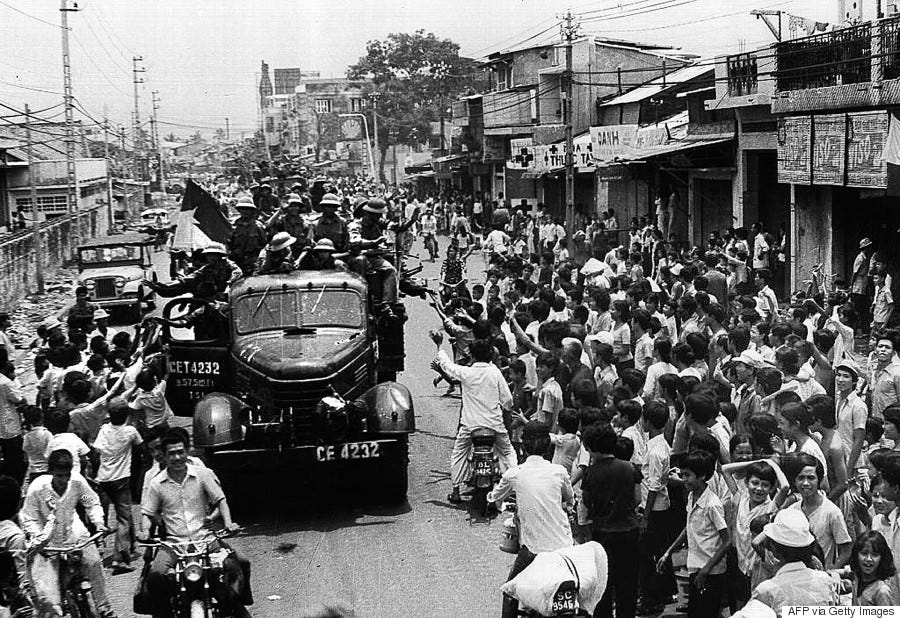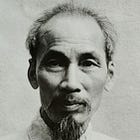
In Ho Chi Minh City, on the occasion of the celebration of the fiftieth anniversary of the Liberation of the South and National Reunification, Cuban Vice-President Salvador Valdés pointed out the clear environment of enthusiasm and happiness among the people. The Great Victory of the Spring of 1975 was an important moment, he noted, in that it provided the foundation for the transformation of Vietnam into a developed, high-income country. It constituted, moreover, the triumph of justice and consciousness not only for the Vietnamese people, but for all the peace-loving peoples of the world.
For his part, To Lam, General Secretary of the Communist Party of Vietnam and President of the Socialist Republic of Vietnam, emphasized that the key to the victory in the war against the United States was the leadership of the Communist Party of Vietnam and of Ho Chi Minh, who led the army and the people in the socialist revolution in the North and the people’s national democratic revolution in the South. He also observed that Vietnam will never forget the moral and material support provided by Cuba in its struggle for national liberation and national reunification.
My commentary of July 8, 2022, “The universal meaning of Vietnam: A heroic struggle for independence and socialism,” reviews the history of Vietnam from ancient times to its Declaration of Independence on September 2, 1945.
The French conquest of Vietnam was initiated in 1859, when French troops attacked Saigon, a commercial port in the Southern region of the Empire of Vietnam. In 1862, the Vietnamese Emperor Tu Duc ceded three Southern provinces to the French, which later would become the French colony of Cochin China. In the 1880s, following the death of Tu Duc, the French invaded again. An accommodationist faction had taken power in the Vietnamese court, and it ceded French influence over the remaining territory. The French proceeded to divide Vietnam into the protectorate of Tonkin in the North, where the traditional capital city of Hanoi was located; and the protectorate of Annam, which included the imperial capital of Hue and stretched from Tonkin to the French colony of Cochin China. The Vietnamese imperial court and its bureaucracy were allowed to govern in the protectorate of Annam, functioning as a puppet authority under the direction of the French.
The peripheralization of Vietnam and its incorporation into the expanding European-centered world-economy was concentrated in the South, in the French colony of Cochin China. The production of rubber and rice for export, on the base of forced and superexploited labor, provided the economic foundation for the colony. Rubber plantations under French ownership were developed along the Cambodian border. Rice was cultivated in the Mekong River delta, where the French had drained the marshlands, by sharecroppers who paid exorbitant rents to absentee Vietnamese landlords living in Saigon. Cochin China became the third largest rice exporter in the world. In addition, several thousand Europeans settled in Saigon during French colonial rule, attracted by nearby rubber, tea, and coffee plantations as well as opportunities vis-á-vis factory ownership and the import-export trade. Saigon became the largest industrial and commercial city of Vietnam, as textile mills, cement factories, and food processing plants emerged.
A nationalist movement in opposition to French colonial rule emerged in the 1890s. It was concentrated in the scholar-gentry class, which had been an important sector in traditional Vietnamese society prior to French colonialism. In the 1920s, a new generation of educated Vietnamese emerged, who originated from the families of the traditional scholar-gentry class, but who were educated in the French educational system. These Western educated intellectuals continued the scholar-gentry tradition of opposition to French colonial domination, and they formed various patriotic nationalist political parties during the 1920s.
Taking advantage of disruptions of French colonial rule occasioned by the German occupation of France and the Japanese occupation of Vietnam during the Second World War, the nationalist movement, by this time led by Ho Chi Minh and the Indochinese Communist Party, was able to take de facto political control in the power vacuum created by the end of the Japanese occupation, by means of people’s assemblies throughout the territory of Vietnam. On August 29, the puppet Emperor Bao Dai abdicated, presenting the imperial seal to a delegation of the forces now in power. On September 2, 1945, before a crowd of one-half million people, continually shouting “independence,” in Ba Dinh square in Hanoi, Ho Chi Minh read the Declaration of Independence of the Democratic Republic of Vietnam (DRV).
Even before the declaration of Vietnamese independence, the French had undertaken military operations to reconquer its former colony, concentrated in the South. However, the new government of Vietnam, located in Hanoi, initiated the work of governing.
The French proposed the secession of Cochin China, with the intention of establishing in the South a government under de facto French control. As noted above, the French colony of Cochin China had extensive rice fields and French-owned rubber plantations. It was the richest and most economically developed region of the country, where three-fifths of French properties in Indochina were located. In response, Ho Chi Minh proposed a transition to independence over a period of several years. At the same time, he rejected French claims for the separation of Cochin China; he demanded the reunification of Vietnam and the nullification of the French colonial division of Vietnam into Tonkin in the North, Annam in the central provinces, and Cochin China in the South.
The French War in Indochina of 1946 to 1955 was won by the newly independent Democratic Republic of Vietnam. In 1949, France had established a Vietnamese government with limited sovereignty under the authority of former Emperor Bao Dai. By 1953, the army of the puppet government, trained by the French with US financial aid, had reached 200,000 troops; and French troops numbered 250,000. However, the DRV of Ho Chi Minh increasingly took control of territory, such that by 1953 nearly all the North was under its control, except for Hanoi and the large cities.
In the battle of Dien Bien Phu, which lasted for fifty-five days from March 13 to May 7, 1954, the forces of the DRV directed by General Vo Nguyen Giap attained a decisive victory. More than 1500 French soldiers were killed, and 4000 were wounded; nearly 16,000 French soldiers were killed, captured, or listed as missing in action, and all the French officers surrendered. By May 1954, the DRV had control of 75% of the national territory. In France, as a result of the failure of the French military occupation to effectively reconquer its former colony, there emerged popular opposition in France to the Indochina War.
The Geneva Conference was convened on April 26, 1954, and peace talks on Indochina began on May 7, the day following the French surrender at Dien Bien Phu. Participating in the peace talks were delegations from France, the Democratic Republic of Vietnam, the United States, Great Britain, China, and the Soviet Union as well as the governments of Bao Dai and the French Indochinese associated states of Laos and Cambodia. On July 21, a cease-fire agreement was signed by France and the Democratic Republic of Vietnam. A separate document, the “Final Declaration of the Conference of Geneva,” recognized the independence of the Democratic Republic of Vietnam, located north of the seventeenth parallel, and the government of Bao Dai, located south of the parallel. It recognized that the final solution of Vietnam remained undefined, pending general elections to be held in July 1956 that would reunify the country; and it mandated consultations between the two zones for implementing the elections. At the last minute, the United States delegation refused to sign the negotiated declaration, because the US government had recently become aware that Ho Chi Minh would overwhelmingly win the proposed 1956 elections.
Following the Geneva Accords of 1954, Ngo Dinh Diem, who had been named Prime Minister by Bao Dai, maintained that South Vietnam would not negotiate with communists concerning the holding of elections. Diem and the United States began to define South Vietnam as a separate and permanent government. They ignored the Geneva proposal for national elections unifying the Northern and Southern zones of Vietnam, and they did not respond to communications from the Democratic Republic of Vietnam seeking cooperation in the holding of reunifying national elections. In 1959, the Vietnamese Workers’ Party (formerly known as the Indochinese Communist Party) endorsed a political-military struggle for the liberation of South Vietnam.
In 1960, the armed struggle was renewed. Armed guerrilla groups began to ambush and annihilate South Vietnamese Army units, with women and children helping with information and supplies. By the end of 1960, half the villages and towns of the South were under the administration of people’s organizations. In order to establish centralized direction of these administrative structures, the National Liberation Front of South Vietnam (NLF) was created. The NLF was established on December 20, 1960, at a conference in the territory of the South organized by the Vietnamese Workers’ Party. In February 1961, paramilitary units in the Mekong Delta and the Central Highlands were merged to form the People’s Liberation Armed Forces (PLAF), known as the “Viet Cong.” PLAF functioned as the military arm of the NLF. It grew to 15,000 troops by the end of 1961. It had carved out a liberated base area in the Central Highlands, and it had established roots in villages and towns throughout South Vietnam.
During the period of 1961 to 1964, in response to the rapid growth of PLAF and the success of the guerrilla struggle, the United States began to utilize Special Forces known as the Green Berets, which were heterodox military forces that had been trained in counterguerrilla activities. The Special Forces trained South Vietnamese troops, and they took direct part in combat in coordination with South Vietnamese troops. The Special Forces carried out a pacification program, involving forced relocation of the people to “strategic hamlets,” which were enclosed by bamboo fences, and where the people were required to present identification cards and could leave and enter only at fixed hours.
By 1964, the NLF controlled 80% of the territory of South Vietnam, dismantling strategic hamlets in areas under its control. And the NLF had the support of the great majority of the population of the South. By 1965, it was clear that the US war carried out by US Special Forces in cooperation with the South Vietnamese army had been lost.
Robert McNamara, Secretary of Defense from 1961 to 1968, writing in retrospect in 1995, maintains that from 1961 to 1964 US policy was based on the premise that South Vietnam must establish itself as a viable and stable nation, albeit with US support. US policymakers did not understand that the South Vietnamese government could not establish itself as a viable government, even with US support, inasmuch as it was a puppet government installed by France and the United States to preserve a colonial presence in the face of the nationalist aspirations of a people who had become politically aware and united. The government of South Vietnam had the support of only the landholding class, the Catholic Church, the allies of the French, and assorted scoundrels.
US leaders, however, could not accept what they viewed as the fall of South Vietnam and possibly Southeast Asia to communism, as McNamara documents. Not seeing that the root of the problem was the puppet character of the South Vietnamese regime, US policymakers arrived to an erroneous conclusion: that the South Vietnamese government could be strengthened by increasing US support. They reasoned that the United States, in limiting its support to military advisors, was signaling a lack of commitment to the government of South Vietnam. They began to believe that US armed intervention with ground troops would increase the credibility and political strength of the government of South Vietnam, thus enabling it to carry out the pacification program more effectively and to assume the role assigned by US policy.
Therefore, from January to July of 1965, US policymakers moved toward a decision to escalate the war and to send a greater number of US troops, which would engage in direct combat. In the beginning of 1965, there had been 23,000 US military advisers stationed in Vietnam. But by the end of 1965, the US military presence increased to 180,000 troops; and by the end of 1966, to 280,000. By 1968, US troops numbered 550,000.
However, the interpretation of US policymakers was erroneous. In fact, increased US military presence further undermined the legitimacy of the South Vietnamese government, in that it completely discredited its claim to represent an independent nationalist force in Vietnam. As the Cuban scholar Julio García Oliveras, who had served in a Cuban military mission in Indochina from 1966 to 1969, writes: “The introduction of US forces produced a great change in the South. Before the puppets could speak of nationalism, now it was made evident before the public that it was a question of an occupation by foreign troops.” He notes that “a rapid increase of the number of puppet troops could not compensate for the intrinsic weakness of a mercenary army that had to combat under foreign command against their own compatriots.”
The People’s Liberation Armed Forces (PLAF) successfully engaged US troops repeatedly. From 1965 to 1967, the United States military command used a “search-and-destroy” strategy. But US troops suffered many casualties, and their operations did not reduce the territory under NLF control. Although the United States had far superior firepower, PLAF decided when, where, and how long to fight, in a war without a front. Meanwhile, the South Vietnamese army had become unreliable for combat, as a result of military defeats and casualties as well as the growing number of desertions.
By 1968, the United States government was on the defensive in the face of the growing opposition to the war in the USA and world public opinion. In 1973, a peace agreement was signed by the government of South Vietnam, the Provisional Revolutionary Government of South Vietnam (which had been established in 1969 and was under the control of the NLF), and the Democratic Republic of Vietnam. The agreement mandated total US withdrawal, which was carried out by March 1973. But the war between the Democratic Republic of Vietnam and the puppet government of South Vietnam continued, as the revolutionary nationalists continued their quest for the reunification of Vietnam.
In the Great Spring Offensive of 1975, the army of the Democratic Republic of Vietnam, commanded by General Tran Van Tra, and PLAF launched a joint offensive, rapidly taking control of the important cities of the South, including Hue and Saigon. Officials of the government of South Vietnam resigned, and political power was assumed jointly by a Military Revolutionary Committee of North Vietnam and the Provisional Revolutionary Government of South Vietnam. A constitutional assembly was held, and a unified nation, the Socialist Republic of Vietnam, was established, with Hanoi as the capital city.
The Encyclopedia Brittanica provides a review of the fall of Saigon.
The capture of Saigon, the capital of the Republic of South Vietnam, by North Vietnamese forces, occurred from March 4 to April 30, 1975. . .. Rampant inflation, glaring corruption, and the loss of US support undermined army morale, with 24,000 troops deserting every month. . ..
In March 1975 the North Vietnamese launched offensives in the Central Highlands and in Quang Tri province in northern South Vietnam. South Vietnamese counterattacks failed as large numbers of troops deserted to protect their families. On March 13, South Vietnam’s President Nguyen Van Thieu ordered his army to withdraw southward, where supply lines would be shorter, but retreat rapidly became a rout as deserters, refugees, and troops clogged roads and spread panic. Emboldened, the North Vietnamese ordered their entire strength on the offensive—Saigon was to fall that spring. . ..
On April 21 Thieu announced his resignation on television, denouncing the United States for betraying South Vietnam in its hour of need. By April 27, Saigon was encircled by 100,000 North Vietnamese troops, but there was hardly a need for such a force. . ..
When an artillery barrage announced that the final assault was about to be launched, there was little resistance left. North Vietnamese troops began to occupy strategic points in the city, and within hours, the South Vietnamese government offered to surrender, but they were ignored even as the last South Vietnamese president, General Duong Van Minh, who had been in power only two days after Thieu fled the country, ordered his soldiers to lay down their arms. The North Vietnamese army saw no need to deny themselves a military victory to crown decades of struggle. At noon on April 30, 1975, a T-54 tank burst through the gates of the presidential palace, an act seen on television across the world.
§
Final Considerations
The fall of Saigon was a key moment in the fall of the American Empire. Today, fifty years later, we can see more clearly that the American Empire has fallen, and why. MAGA, a political movement of the working class and of rural and small-town America, called into being and led by Donald Trump, seeks to resurrect the American Republic.
A free subscription option is available, with capacity to read, send, and share all posts. A paid subscription ($5 per month or $40 per year) enables you to make comments and to support the costs of the column; paid subscribers also receive a free PDF copy of my 2018 book, The Evolution and Significance of the Cuban Revolution.






